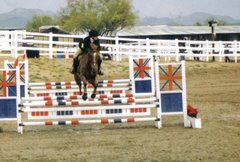 shows a few of the important organelles that can be found in real cells. There are 3 pictures to the right. The first one is of my supplies before starting the project. The 2 is of my cell partway through construction. The 3 is the final completed cell.
shows a few of the important organelles that can be found in real cells. There are 3 pictures to the right. The first one is of my supplies before starting the project. The 2 is of my cell partway through construction. The 3 is the final completed cell.- Yellow Foam ball- represents the nucleus. The nucleus contains chromosomes and controls the function of the cell.
- Ceran wrap- represents the nuclear membrane. This is a double membrane surrounding the nucleaus while also attatching to the rough ER. The membrane contains pores that allow substances to pass between the nucleus and cytoplasm.
- Colored string- represents chromosomes- these are chromatin condensed into a
 compact structure. Chromatin are a network of fine threads in the nucleus made up of DNA and proteins.
compact structure. Chromatin are a network of fine threads in the nucleus made up of DNA and proteins. - Purple twist ties- represent the rough endoplasmic reticulum. This is system of membranes and channels studded with ribosomes. Proteins are synthesized here
- Nails- represent the ribosomes on the rought ER. In the cytoplasm, this is where protein synthesis occurs, they are made up of RNA and protein in subunits
- Sponge- represents the smooth endoplasmic reticulum. This is connected to the rough ER, but is without ribosomes. The smooth ER synthesizes phospholipids

- Orange felt- represent mitochondria. Cellular respiration occurs here, producing ATP for energy
- Bright green twist ties- represent lysosomes. These are vesicles that contain hydrolytic enzymes for digesting macromolecules
- Dark Green twist ties- represent the golgi apparatus, made up of vesicles, and saccules that process, package and distribute molecules from the cell
- Tan twist ties- represent vesicles. These are membrane bound sacs that store substances in the cell
- Blue duct tape- represents the cell membrane. This regulates the exit and entrance of molecules into or out of the cell.
 This picture show DNA replication on the left, and transcription on the right. The pink twist tie is the strand of mRNA that is getting the template from the original DNA
This picture show DNA replication on the left, and transcription on the right. The pink twist tie is the strand of mRNA that is getting the template from the original DNA
This shows the process of translation where the mRNA interacts with ribosomes. The tRNA carries the amino acid to the mRNA where the anti-codon and codon form base pairs and a polypeptide chain is formed.
For me this lab was useful in the fact that I began to understand the concepts better by physically having to put them together, however "making" these models was more difficult for me rather then drawing them. I also did not have as much time as I would have liked to set aside for this project, so I made do with what I had around the house . Overall it was a beneficial lab, and I'm glad it is finished.

No comments:
Post a Comment